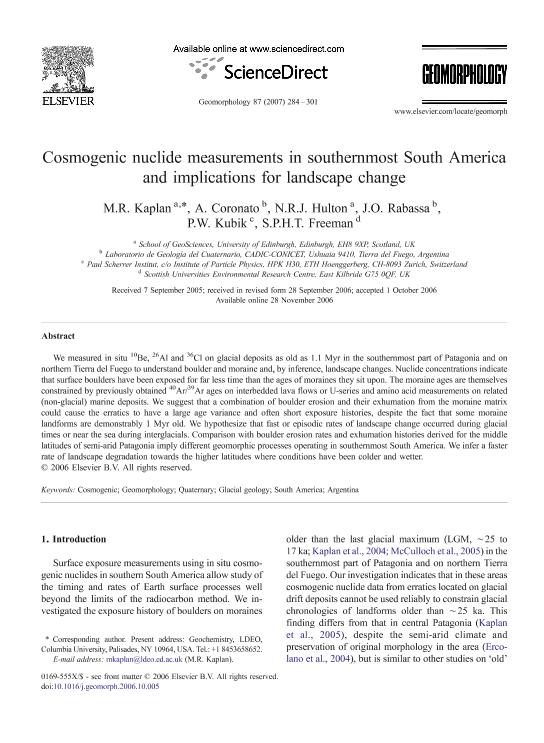Mostrar el registro sencillo del ítem
dc.contributor.author
Kaplan, M.R.
dc.contributor.author
Coronato, Andrea Maria Josefa

dc.contributor.author
Hulton, N.R.J.
dc.contributor.author
Rabassa, Jorge Oscar

dc.contributor.author
Kubik, P.W.
dc.contributor.author
Freeman, S.P.H.T.
dc.date.available
2022-02-03T12:20:04Z
dc.date.issued
2007-07
dc.identifier.citation
Kaplan, M.R.; Coronato, Andrea Maria Josefa; Hulton, N.R.J.; Rabassa, Jorge Oscar; Kubik, P.W.; et al.; Cosmogenic nuclide measurements in southernmost South America and implications for landscape change; Elsevier Science; Geomorphology; 87; 4; 7-2007; 284-301
dc.identifier.issn
0169-555X
dc.identifier.uri
http://hdl.handle.net/11336/151226
dc.description.abstract
We measured in situ 10Be, 26Al and 36Cl on glacial deposits as old as 1.1 Myr in the southernmost part of Patagonia and on northern Tierra del Fuego to understand boulder and moraine and, by inference, landscape changes. Nuclide concentrations indicate that surface boulders have been exposed for far less time than the ages of moraines they sit upon. The moraine ages are themselves constrained by previously obtained 40Ar/39Ar ages on interbedded lava flows or U-series and amino acid measurements on related (non-glacial) marine deposits. We suggest that a combination of boulder erosion and their exhumation from the moraine matrix could cause the erratics to have a large age variance and often short exposure histories, despite the fact that some moraine landforms are demonstrably 1 Myr old. We hypothesize that fast or episodic rates of landscape change occurred during glacial times or near the sea during interglacials. Comparison with boulder erosion rates and exhumation histories derived for the middle latitudes of semi-arid Patagonia imply different geomorphic processes operating in southernmost South America. We infer a faster rate of landscape degradation towards the higher latitudes where conditions have been colder and wetter.
dc.format
application/pdf
dc.language.iso
eng
dc.publisher
Elsevier Science

dc.rights
info:eu-repo/semantics/openAccess
dc.rights.uri
https://creativecommons.org/licenses/by-nc-sa/2.5/ar/
dc.subject
ARGENTINA
dc.subject
COSMOGENIC
dc.subject
GEOMORPHOLOGY
dc.subject
GLACIAL GEOLOGY
dc.subject
QUATERNARY
dc.subject
SOUTH AMERICA
dc.subject.classification
Geología

dc.subject.classification
Ciencias de la Tierra y relacionadas con el Medio Ambiente

dc.subject.classification
CIENCIAS NATURALES Y EXACTAS

dc.title
Cosmogenic nuclide measurements in southernmost South America and implications for landscape change
dc.type
info:eu-repo/semantics/article
dc.type
info:ar-repo/semantics/artículo
dc.type
info:eu-repo/semantics/publishedVersion
dc.date.updated
2022-01-06T15:02:48Z
dc.journal.volume
87
dc.journal.number
4
dc.journal.pagination
284-301
dc.journal.pais
Países Bajos

dc.journal.ciudad
Amsterdam
dc.description.fil
Fil: Kaplan, M.R.. University of Edinburgh; Reino Unido
dc.description.fil
Fil: Coronato, Andrea Maria Josefa. Consejo Nacional de Investigaciones Científicas y Técnicas. Centro Austral de Investigaciones Científicas; Argentina
dc.description.fil
Fil: Hulton, N.R.J.. University of Edinburgh; Reino Unido
dc.description.fil
Fil: Rabassa, Jorge Oscar. Consejo Nacional de Investigaciones Científicas y Técnicas. Centro Austral de Investigaciones Científicas; Argentina
dc.description.fil
Fil: Kubik, P.W.. Universitat Zurich; Suiza
dc.description.fil
Fil: Freeman, S.P.H.T.. Scottish Universities Environmental Research Centre; Reino Unido
dc.journal.title
Geomorphology

dc.relation.alternativeid
info:eu-repo/semantics/altIdentifier/url/https://www.sciencedirect.com/science/article/pii/S0169555X0600448X?via%3Dihub
dc.relation.alternativeid
info:eu-repo/semantics/altIdentifier/doi/https://doi.org/10.1016/j.geomorph.2006.10.005
Archivos asociados
